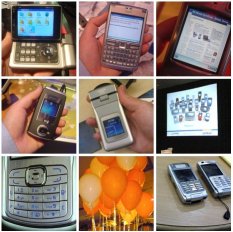It's Crystal Ball Time
Yes, the start of the year is when web,sites look back and look forward. To see if what we thought would have happened, happened, and to make a wild stab at what might happen over the next twelve months. Time for All About Symbian to have a go.
Looking Back At Our 2005 Predictions
So, how did we do with the predictions for 2005? Well, prepare to have a good laugh, because they weren't very accurate!  Sendo and Panasonic did produce new S60 phones, but with Sendo going to the wall and Panasonic giving up on Symbian development we are not going to be seeing any more from them. The N-Gage 3 did not make an appearance and isn't likely to any time soon. Indeed, Nokia look set to change to an 'N-Gage inside' strategy in 2007/2008. The N-Gage game portfolio does remain healthy though and there are some more standout releases on the horizon. The rumoured new interface did not make an appearance, but S60 3rd Edition did. The shape and diversity in form factor predicted for S60 in 2005 has appeared - mainly thanks to the E-series devices.
Sendo and Panasonic did produce new S60 phones, but with Sendo going to the wall and Panasonic giving up on Symbian development we are not going to be seeing any more from them. The N-Gage 3 did not make an appearance and isn't likely to any time soon. Indeed, Nokia look set to change to an 'N-Gage inside' strategy in 2007/2008. The N-Gage game portfolio does remain healthy though and there are some more standout releases on the horizon. The rumoured new interface did not make an appearance, but S60 3rd Edition did. The shape and diversity in form factor predicted for S60 in 2005 has appeared - mainly thanks to the E-series devices.
UIQ 3 still hasn't really got going, and although we did see the announcement of the next P-Series phone, there was not the range of devices I was expecting. However I think this might be just a matter of getting the timing wrong. One oddity for UIQ was the Nokia UIQ phone, although as a one off BenQ rebrand it was not very significant, except to highlight the time it is taking to roll pen input into S60.
As predicted, there was no 3G Communicator, but the 9300i provided an expected stop gap.
Symbian OS 9 did make an appearance and there were more strategic alliances, but I underestimated the number of devices sold by 10 million. Symbian and DoCoMo's work with manufacturers on FOMA phones is one of the unheralded success stories for Symbian in 2006. FOMA phones now make up a significant portion of Symbian licensee fee income and with Symbian as one of DoCoMo's two preferred platforms, that trend is set to continue.
In conclusion, I said that the smartphone was set to go mainstream, and in fairness it has. In the UK at least, smartphones are common, although not everyone realises they own a smartphone and even fewer know they own a S60 or UIQ-powered phone, and only a smaller minority realise their phone runs on an OS made by a company based in the UK.
Now it is time to retrieve the crystal ball from the dog's kennel and see what lies ahead this year...
2006 Predictions
Devices
- More than 100 million Symbian OS devices will have been sold (total since Symbian's inception).
- The devices announced this year will move Symbian towards to the 100's of millions of devices per year mark for 2007-2009.
 The minimum Bill of Materials cost for a Symbian device will drop below $100 for the first time.
The minimum Bill of Materials cost for a Symbian device will drop below $100 for the first time.- Integrated GPS capability will be the next major trend in device hardware convergence.
- S60 will have another bumper year and I think it will ship around 75 million devices, though there is a predicted range of 40-80 million from various sources. The installed user base will increase from around 38 million to more than 110 million.
- UIQ devices will improve from 2005 to a figure of several million, thanks to the availability of the P990 in March, but significant numbers may have to wait untill more devices are announced.
- 2 million Series 80 devices will be sold, thanks to the continued popularity of the device family and the availability of the 9300i from February.
- New devices in both the N series, E series and standard Nokia ranges with models ranging from the high end to the low mid tier. Most high end devices will have integrated WiFi, and some will also have integrated GPS capabilities. The majority of new devices will use S60 3rd Edition, but some budget devices will use earlier versions. The first announcements will be at 3GSM, with more following throughout the year. We should expect 20-plus new S60 devices this year from Nokia (compared to 12 this year). There will also be new S60 devices from Samsung and Lenovo, and possibly LG. There will be an increasingly wide range of shape, features and form factors, as allowed by S60 3rd Edition.
- Announcement of the first S60 touch-screen devices, the fruits of the time consuming Series 90 integration into S60.
- Up to 7 new UIQ devices will be announced this year (up from 2 last year). We can expect multiple new UIQ devices from both Sony Ericsson and Motorola. Additional devices from at least one more company. At least some of these will not have touchscreens and will compete directly with S60.
- FOMA devices will continue to add to Symbian numbers with up to 10 new phones announced this year.
Symbian and OS Updates
- The ownership issues surrounding Symbian will have to be resolved. At the current time, outstanding issues include the fate of Siemens holdings (it does not necessarily automatically go to BenQ), and what both Panasonic and BenQ wish to do with their holdings given their stated to intention to focus of Linux and Windows Mobile respectively. The psychologically important 50% ownership may be achieved by Nokia (though it would confer no more power or influence over
 Symbian than their current holding). However Nokia may forgo its right to an proportional share of any holding being sold in favour of maintaining the status quo. Instead the holdings of Siemens, BenQ and Panasonic might be taken up by a combination of Sharp, Sony Ericsson and Mitsubishi.
Symbian than their current holding). However Nokia may forgo its right to an proportional share of any holding being sold in favour of maintaining the status quo. Instead the holdings of Siemens, BenQ and Panasonic might be taken up by a combination of Sharp, Sony Ericsson and Mitsubishi. - We should see version 10 of the Symbian OS, which is expected to build on the cost reduction features of OS 9 (such as the support for real time, single chip phones) and will look to build in new wireless technologies. Announced at 3GSM or perhaps more likely later in the year at Expo.
- S60 3rd Edition will see its second Feature Pack which should add to the advances in device customisation announced in Feature Pack 1.
- The first update to UIQ 3 will be announced, but is likely to be a small revision as was seen with UIQ 2.1. It is possible that formal support for an additional form factor (the clamshell style communicator) will be added.
- New licensees for Symbian, UIQ and S60 from lesser known companies based in the Far East.
Elsewhere in the Ecosystem
- There will be more activity from the search engine giants in the mobile space in 2006. Yahoo look set to announce the Yahoo Phone (a S60 phone preloaded with Yahoo services and content), and Google may follow suit. More generally, Yahoo, Google and MSN will look to mobilise their service offerings. Expect everything from heavy competition in local search to casual games.
Update: Since writing this Yahoo announced Yahoo Go Mobile at CES, which fulfills part of this prediction. They also announced a partnership with several US carriers and Nokia to distribute the new service. An announcement at 3GSM may revolve around the addition of the Yahoo Music service to the Go service, and we can expect Google and MSN to continue updating their mobile offerings through the year. Yahoo will likely lead in the integrated approach, MSN will gain traction via closer integration with the Windows Mobile platform, while Google's scatter gun approach of multiple poorly integrated services may be less effective, even when the services are impressive. - GYM (Google/Yahoo/MSN) showing interest in mobile is part of a wider trend. Symbian will be well placed to continue as the de facto launch platform for many complex mobile services due to its ever increasing user base and popularity among early adopters and technology enthusiasts.
- VoIP services support for Symbian handsets will become available, although these will, for the most part, only operate effectively over WLAN connections. Skype looks set to make an announcement at 3GSM, but there will be others, not least the Enterprise focused offerings available with the E Series of phones.
Challenges for the year ahead
Symbian's success thus far has largely been based on Nokia's success with the S60 platform, and while this trend will continue, the continued growth of FOMA phones and a resurgence of UIQ will mean a more diversified, and therefore more healthy Symbian. However, questions of ownership will generate perceived problems in the media and may lead to internal political difficulties. As ever, Symbian should be aware of the challenges arising from its unique structure and ensure that they do not impact the effectiveness of company operations or its core activity - software development. Symbian will need to continue to be mindful of the potential and required features in emerging markets, especially in India and China. Good progress has been made in lowering the build cost of Symbian phones, and this must continue to drive the BoM cost below $80.
Nokia Platforms needs to address questions about the relevancy of its license-to-third-party strategy as devices from non-Nokia manufacturers have failed to emerge in significant numbers. With increasingly feature-rich devices, a focus on improving the ease of use, usability, and communicating the available functionality to end users is essential. A renewed focus on the feature set of the basic on board applications may be necessary as the demands placed by users on them continue to grow.
UIQ needs to prove that version 3 of its UI product can result in cost savings for manufacturers during development and integration and result in bestselling phones popular with consumers.
Generally, Symbian, UIQ and Nokia Platforms must not lose sight of the importance of developers. With several communication missteps in the first half of 2005 relating to the changes resulting from the compatibility break and new security model in OS 9, all three should continue and improve upon the work of the second half of the 2005 to ensure developers are provided with the information and support they need.
Conclusion
Continued growth and success is the forecast for 2006, but Symbian and companies within the wider ecosystem should not become complacent. 2006 will also see increasingly credible competition from Microsoft's Windows Mobile in high tier devices, begin to emerge from Linux (from multiple vendors) and continue from propietary operating systems in middle tier devices.
What are your thoughts, what do you think will be big this year? Leave your opinion and feedback in the comments thread.
